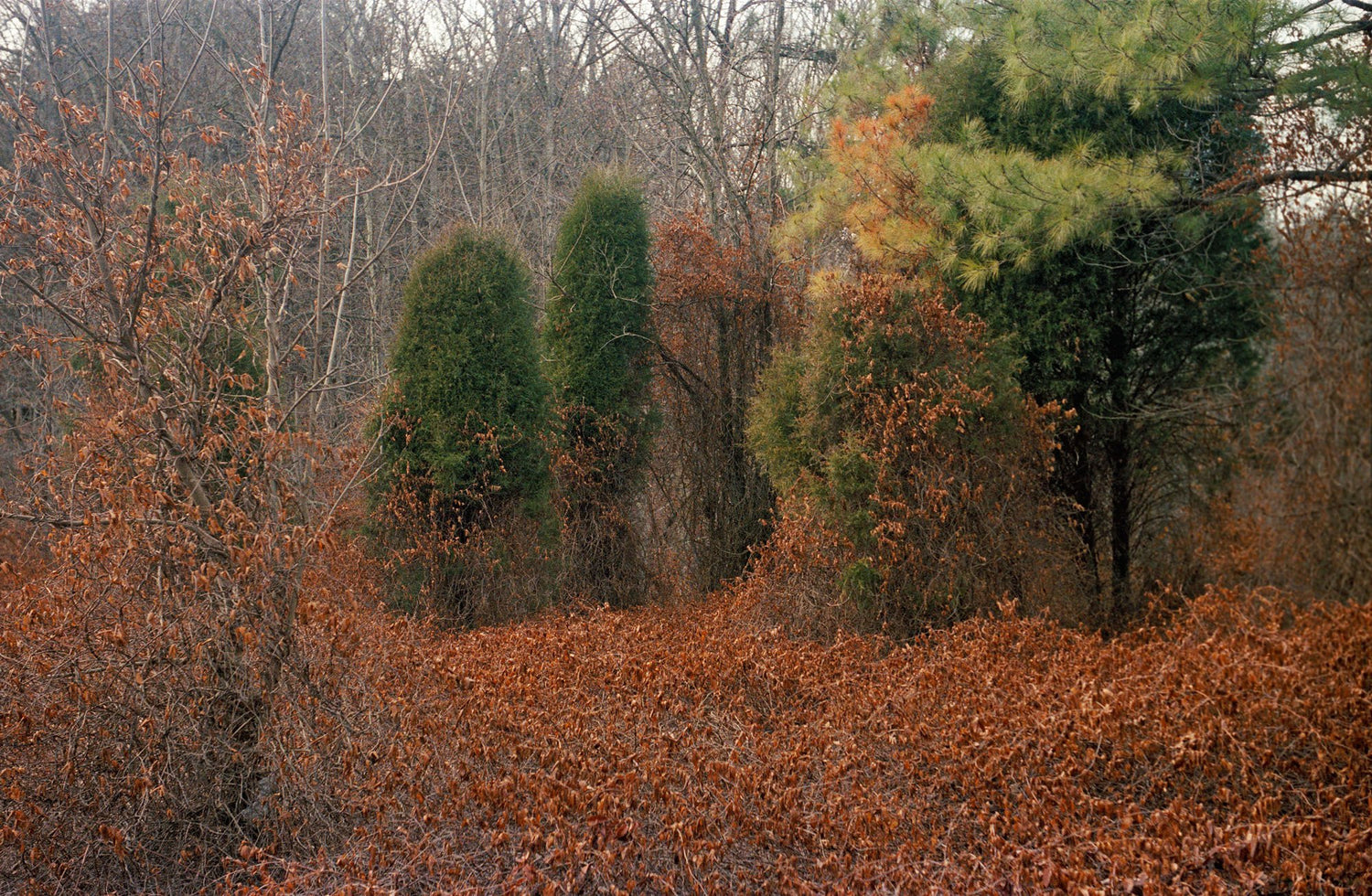I’d always thought of the title of William Eggleston’s The Democratic Forest as a sort of mischevious redundancy. Left to its own devices, a forest is a model of democracy, and it can hardly be otherwise. It takes human intervention in the form of monoculture to strip the diversity from the woods, making them more easily exploitable but less able to survive in a challenging environment on their own. In its recent and weighty Steidl expansion, Eggleston’s forest has suffered just such an intrusion. And to similarly ill effect.
The original version of The Democratic Forest was published in 1989 with 148 pictures, plus a charming portrait of Eudora Welty – who wrote the introduction – and a smart photograph of the man himself. It’s a real good book. The new boxed set contains ten volumes, with a total of more than a thousand images. Which is just a fraction of the 12,000 negatives, give or take, that Eggleston made in the ‘80s for the project.
In the first book’s afterword, Eggleston described to Mark Holborn (the editor of that 1989 publication, and the co-editor with William Eggleston III of the Steidl) the epiphany that helped him make sense of all those pictures.
. . . It was one of those occasions when there was no picture there. It seemed like nothing, but of course there was something for someone out there. I started forcing myself to take pictures of the earth, where it had been eroded thirty or forty feet from the road. There were a few weeds. I began to realize that soon I was taking some pretty good pictures, so I went further into the woods and up a little hill, and got well into an entire roll of film.
Later, when I was having dinner with some friends, writers from around Oxford, or maybe at the bar of the Holiday Inn, someone said, ‘What have you been photographing here today, Eggleston?’
‘Well, I’ve been photographing democratically,’ I replied.
'But what have you been taking pictures of?’
‘I’ve been outdoors, nowhere, in nothing.’
'What do you mean?’
‘Well, just woods and dirt, a little asphalt here and there.'
What’s really critical here is that when Eggleston is asked about subject matter, he responds instead with a mindset. His friends (some particularly literal writerly folk, it appears) wanted nouns, but he offered an adverb. Not at all critical but nonetheless awesome is that they called him by his last name.
Anyway – and please mark these words – Eggleston goes on to say: “From that moment everything from the boxes of thousands of prints made cohesive sense for the first time. All the work from this period from 1983 to 1986 was unified by a democracy.”
Now one can argue whether this set of pictures (in either incarnation) is indeed democratic, but it’s nonetheless where Eggleston was coming from, and I totally buy his assertion of democracy as the unifying construct in his head. In fact, that second part of his quote above indicates that he himself understood that his concept shifted from a democracy in the world (discovered on that day spent shooting woods and dirt and asphalt) to a democracy in his work (made over a number of years in a variety of places).
And the damage done to that democracy in the work is ultimately why the Steidl reissue is a disappointment.
To be sure, as far as disappointments go, it’s not a disqualifying one. I’m glad to own the book. Hell, I’m glad to have had enough freelance work over the past several months to justify the cost, even at the substantial discount I got. Know this: if you like Eggleston’s work, you’ve got hours (and hours) of entertainment and enlightenment ahead of you.
But.
Well, there are three things, in ascending order of seriousness: 1) the way the pictures look; 2) the new introduction; and 3) the whole damned construct of the thing.
If you are at all familiar with the 1989 The Democratic Forest, you are in for a bit of pictorial revisionism. The images in the new book (not all, but many, and let that be the caveat henceforth) are crispy. It’s like the old book was breaded chicken that was oven-baked, and the new one is seriously deep fried. It’s all a matter of taste, I suppose; both can be delicious, though there are notable nutritional differences. And then also the greens sort of oscillate wildly; the first dozen pictures in the first Steidl volume are just totally bonkers with the foliage. So at least we can confirm that there’s a thriving ancient-Athens-style democracy in which each and every shade of green has its say.
But let's move to Mark Holborn’s new introduction, which is refreshingly artspeak-free for the most part. He does a nice job explaining the shift in the compositions from the pictures in William Eggleston’s Guide to the work at hand (but then he says that to see a similar change “you have to turn as far afield as Braque’s Zen influenced late paintings,” and you think well, this fellow does know from “far afield” alright). The high point – in a separate “Note on the Eudora Welty Introduction” – is an honest-to-god hilarious anecdote from a meeting with Welty in which she misread a dirty word on a brick wall in one of Eggleston’s photographs.
Otherwise, though, the introduction is problematic; in fact it pretty clearly describes the trouble with the Steidl thing as a whole. Surprisingly deep into Holborn’s essay, we get to the crux of the deal: “The division of the publication into ten volumes is an editorial construction.” Which statement is strange not only because every book ever made is an “editorial construction,” but also because in the case of this reissue it's glaringly obvious.
But onward: “Eggleston never conceived of more than a sea of pictures. They were piled on the piano or dining room table and lay in stacks around his Memphis home. He dwelt in the photographs, not in their separation into distinct volumes.”
He dwelt in the photographs. That’s both really lovely and entirely true, as we’ve already seen. But so how does Holborn justify that stuff after the comma, that stuff about separation into distinct volumes, that stuff that he did?
Turns out: he doesn’t. The very next sentence, not even in a new paragraph, is this: “The work was grouped round the passage through specific locations.” And now we are off on a long and embarrassingly didactic discussion of how the ten volumes are to be understood. The central animating idea of not only a borderline canonical book, but of a years-long project of 12,000 photographs, is thus quickly swept aside.
And so, instead of a democracy? Welcome to the subject matter ghetto, where everything has to be a noun – easily categorized and filed – or nothing at all. No unwieldy adverbs here. To wit: Volume 2, which is called “The Language,” and which contains exclusively photographs in. which. there. are. words. No shit.
The third volume is “Dallas. Oil. Miami.” and you sort of hope that perhaps “oil” is a verb mistakenly made plural rather than singular. But still it’s the most compelling of the specific location titles, which are “Pittsburgh” (Volume 4) and “Berlin” (Volume 5).
Volume 6 is “The Pastoral,” and by now you’re surely way ahead of me; Volume 7 is “The Interior.” But wait: next in line is a volume that’s called “The Surface,” for heaven’s sake. The surface. As if that’s not what photographers are always and forever bound to. Here’s Papageorge:
Photography investigates no deeper relief than surfaces. It is superficial, in the first sense of the word; it studies the shape and skin of things, that which can be seen. By passionate extension of this, its most profound meanings have to do with immanence, the indwelling grace of what Zen calls our ten thousand facts. This is not transport, or celestial transcendence, but that more footed joy and grief found near any clear sighting of the world.
One wonders if the Buddha had anticipated that someone would take him up literally on those ten thousand facts, and then even raise him by two grand; but really what deity could have anticipated Eggleston? The problem is that when we’re told that what we’re looking at is “the surface,” and that the surface should be the focus of our attention, the viewer is preemptively thwarted in the act of passionate extension that leads to that place of joy and grief that should attend the clear sighting of the world. Which clear sighting is Eggleston’s stock in trade.
“By the time you reach the eighth volume, The Surface, you will have fully entered the forest,” Holborn writes. Well I guess it’s good it only took us 700 or so pictures to get there, but I’d have thought that the forest should have been all around us from the get-go, that we’d have at least scratched that surface by now. And but then to top it off Volume 9 is called “The Forest,” like we still weren’t really there yet.
Such is the overly-defined and ultimately suffocating terrain of this book: the language, the pastoral, the interior, the surface. It seems a cruel joke to play on a man whose most famous aphorism is “I am at war with the obvious.” Which aphorism, by the way, originally appeared in print in 1989, in The Democratic Forest.

